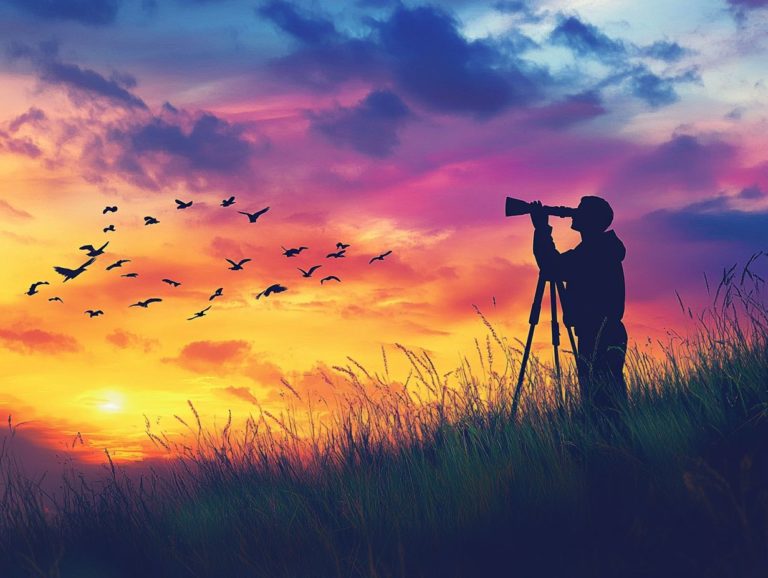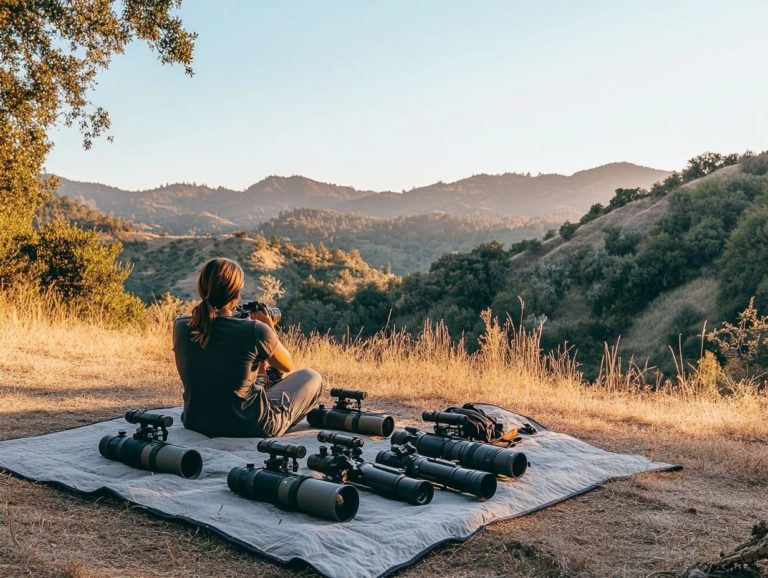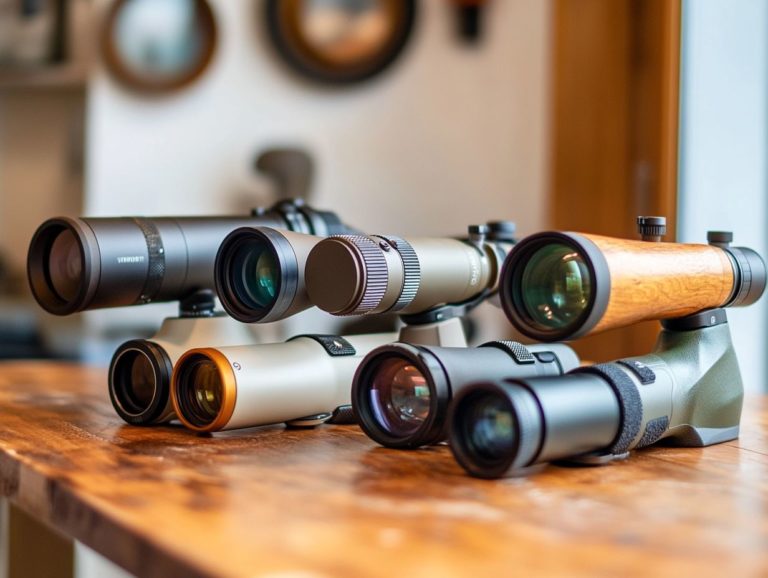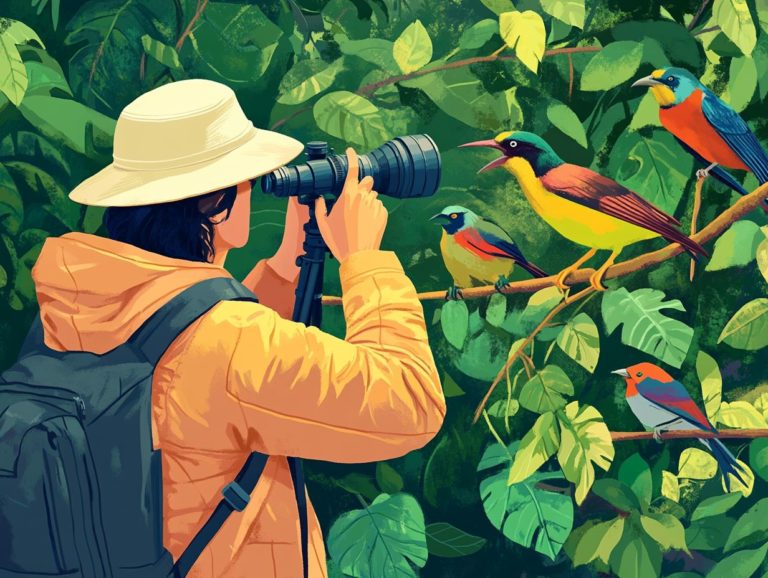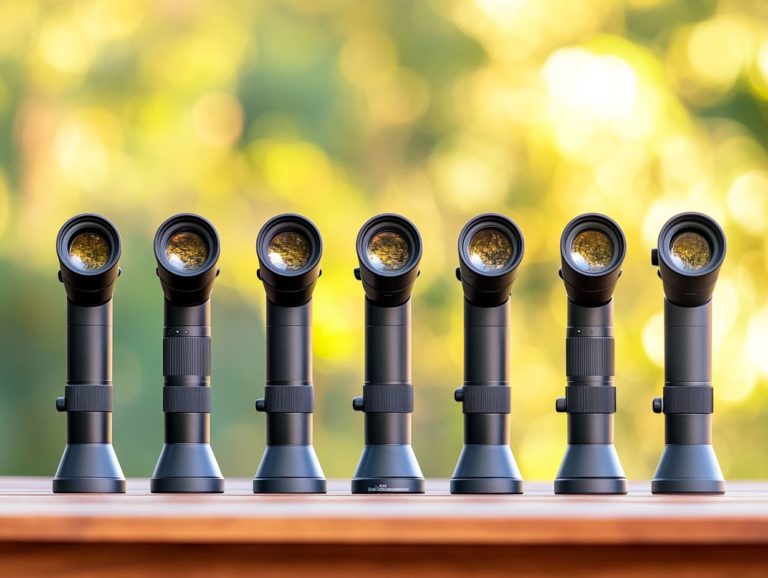5 Ways to Enhance Your Spotting Scope Experience
Are you ready to elevate your outdoor experiences? Selecting the right spotting scope can make all the difference!
This article delves into five essential tips that will enhance your spotting scope journey, from the significance of investing in quality optics to the advantages of utilizing filters for clearer viewing.
You ll learn how to choose the perfect scope tailored to your needs, the benefits it offers, maintenance tips to keep it in top shape, common mistakes to avoid, and strategies to optimize your time in the field.
Dive in to uncover how to maximize your spotting scope experience!
Contents
- Key Takeaways:
- 1. Invest in Quality Optics
- 2. Use a Tripod for Stability
- 3. Adjust the Focus and Magnification
- 4. Utilize Filters for Better Viewing
- 5. Consider Adding a Digiscoping Attachment
- How Can You Choose the Right Spotting Scope for Your Needs?
- Frequently Asked Questions
- What are the five ways to enhance my spotting scope experience?
- Why is adjusting the focus important for a better spotting scope experience?
- How can using a tripod improve my spotting scope experience?
- What is the purpose of a sunshade on a spotting scope?
- Why should I regularly clean the lenses of my spotting scope?
- How can a phone adaptor enhance my spotting scope experience?
Key Takeaways:
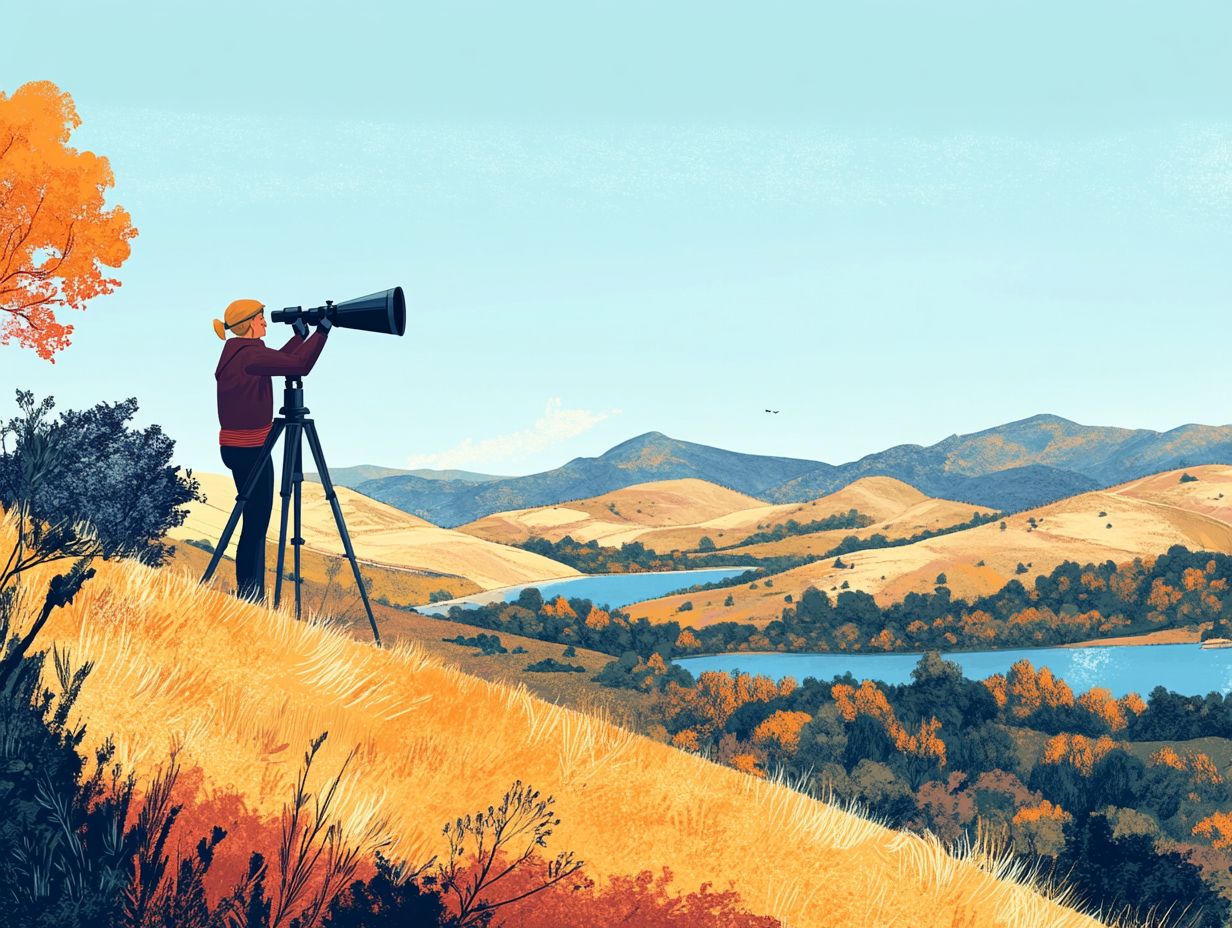
- Invest in a high-quality spotting scope to ensure clear and accurate views.
- Grab a tripod to steady your scope and enjoy a crystal-clear view!
- Adjust focus and magnification to get the best image resolution.
1. Invest in Quality Optics
Investing in quality optics is essential for achieving top-notch performance in wildlife observation and nature viewing. High-definition spotting scopes, such as the Nikon Fieldscope ED 82 A and Celestron C90, feature advanced lens coatings that elevate image quality by minimizing image distortions and enhancing lens performance. Additionally, don’t forget about spotting scope accessories you shouldn’t miss to ensure you have a truly remarkable viewing experience.
These features are crucial for clear images. Superior lens quality translates directly to improved sharpness and brightness, allowing you to catch every fine detail in your observations. The use of premium lens coatings is crucial for reducing glare and unwanted reflections, resulting in crisp visuals, even in challenging lighting conditions.
Comfort plays a vital role too. Ergonomic designs and better weight distribution make those extended viewing sessions much more enjoyable. Prioritizing quality optics immerses you in nature’s wonders, transforming every outing into a memorable adventure.
2. Use a Tripod for Stability
Using a tripod for stability is crucial when you re diving into wildlife observation. It significantly enhances image steadiness, creating a more enjoyable viewing experience especially at high magnification settings, where even the slightest movement can create air shimmer and blur your clarity.
This equipment minimizes pesky shakes that can distort your view and allows you to maintain focus on your subjects without constantly adjusting your grip. By providing a solid platform for your optics, it alleviates the strain that often comes with long hours of observation.
A camera tripod can also enhance tripod stability. Ultimately, a tripod elevates the entire experience, offering a practical solution while deepening your connection to the wildlife you re watching.
3. Adjust the Focus and Magnification
Adjusting the focus and magnification of your spotting scope is essential for achieving optimal image quality. This allows you to fine-tune your zoom settings and eyepiece magnification, enabling you to capture the finest details of wildlife, even amid varying distances and lighting conditions.
Not only does this enhance clarity, but it also ensures that you can spot every subtle movement without straining your eyes. When selecting the right eyepiece, consider options that offer different magnification levels these can dramatically influence your field of view.
Effectively managing focal length means being mindful of how far or close an object is. A good rule of thumb is to adjust the focus dial slowly, paying attention to how these changes impact the sharpness of your view. Additionally, be aware of thermal waves distortions caused by heat in the environment and heat haze that might affect your observations.
By mastering these adjustments, you’ll truly appreciate the beauty unfolding in nature, making every outdoor excursion that much more rewarding.
What are your favorite tips for using a spotting scope? Share your experiences with us!
4. Utilize Filters for Better Viewing

Utilizing filters will dramatically enhance your viewing experience! They improve image contrast and minimize the impact of heat distortions in the air during wildlife observation. For any serious bird watcher or nature enthusiast, filters are an essential tool.
Filters come in a variety of types, each designed to tackle specific challenges. For instance, polarizing filters effectively reduce glare from reflective surfaces, allowing you to spot birds perched near water or shiny foliage with remarkable clarity.
Neutral density filters are another excellent choice. They help balance exposure levels during bright sunlight, ensuring that both highlights and shadows retain their details in your images.
UV filters provide a protective layer for your lens while enhancing color vibrancy, offering a crisp and clear view even in challenging conditions. Selecting the right filter can genuinely transform the quality of your outdoor viewing experience.
5. Consider Adding a Digiscoping Attachment
Adding a digiscoping attachment to your spotting scope opens up a realm of possibilities in digital photography. You can capture breathtaking images of wildlife with either a smartphone adapter or a dedicated digiscope adapter all while sharing experiences with others.
This innovative approach not only enhances your photography skills but also deepens your connection with the natural world. By using smartphone adapters, you can easily align your device, maximizing the optical capabilities of your scope.
Familiarizing yourself with the settings can lead to stunning, high-resolution images. The benefits of combining the sharp optics of a spotting scope with modern technology are immense; you’ll achieve crystal-clear detail that far surpasses the typical smartphone experience. To enhance your experience further, consider the best practices for carrying your spotting scope.
In essence, digiscoping beautifully blends adventure and technology, making your photographic endeavors both thrilling and rewarding.
How Can You Choose the Right Spotting Scope for Your Needs?
Choosing the right spotting scope requires considering many factors think quality optics, objective size, and whether a waterproof feature is essential for your adventures. Each of these elements significantly shapes your viewing experience and the scope’s performance in various conditions.
To ensure optimal functionality, evaluate the objective lens size. Larger lenses gather more light, resulting in brighter, clearer images, especially in low-light situations when every detail matters.
If you often face challenging weather, prioritizing waterproof capabilities is essential. This feature safeguards the internal components against moisture damage, enhancing durability and reliability during unpredictable outings.
Ultimately, investing in high-quality optics not only elevates image clarity but also improves color fidelity, capturing precise details vital for serious bird watchers and wildlife enthusiasts.
What Are the Benefits of Using a Spotting Scope?
The benefits of using a spotting scope for wildlife observation are remarkable. With high magnification, exceptional image stability, and enhanced comfort for those long viewing sessions, it becomes an essential tool for bird watchers and nature enthusiasts. Before heading out, make sure to check out field testing your spotting scope to ensure you get the most out of your gear.
Unlike regular binoculars, which can leave your eyes feeling strained after extended use, spotting scopes provide an immersive experience with superior zoom capabilities. You can inspect distant subjects in detail without sacrificing clarity.
The ergonomic design of spotting scopes allows you to maintain a comfortable viewing position for hours, effectively reducing fatigue. With adjustable tripod mounts, they offer stability that binoculars cannot match, ensuring you can appreciate the beauty of the natural world without disruptions from shaky hands.
What Are the Different Types of Spotting Scopes Available?

Spotting scopes come in various types, tailored for specific activities like bird watching, nature observation, and photography. For instance, models such as the Nikon Fieldscope ED 82 A and Celestron C90 exemplify options featuring waterproof designs and high-performance optics. These often include ED coated lenses that minimize distortions in the image.
If you want portability, you ll find compact models that boast lightweight constructions without compromising on quality perfect for hiking adventures. If your focus is on target shooting or long-distance observation, high-magnification scopes are available, often equipped with advanced prism systems that enhance image clarity.
You might also consider specialized scopes. Look for scopes with:
- Adjustable eyepieces
- Rotating tripod mounts
- Built-in reticles
These variations cater to a wide range of activities, from wildlife observation to astronomical viewing. By understanding these differences, you can make the right choice based on your preferences and intended applications.
How Can You Properly Maintain Your Spotting Scope?
Proper maintenance of your spotting scope is essential for preserving lens quality and ensuring consistent image clarity over time. This involves regular cleaning and care, often supported by customer support from manufacturers.
Start by cleaning the lenses with a microfiber cloth and a lens cleaning solution specifically formulated for optical surfaces. Avoid abrasive materials, as they can cause irreversible damage.
When your scope isn t in use, store it in a protective case to shield it from dust and moisture, ultimately prolonging its lifespan. If you encounter any issues or have concerns about your spotting scope s performance, don t hesitate to reach out to customer support for invaluable assistance and guidance.
What Are Some Common Mistakes to Avoid When Using a Spotting Scope?
Using a spotting scope effectively requires attention to common mistakes, such as overlooking user comfort, neglecting necessary breaks to prevent eye fatigue, and mishandling the equipment. For beginners, following spotting scope use tips can help avoid damage or diminished performance.
Many users underestimate the importance of a stable base, which significantly impacts the clarity of your view. Struggling with improper focus or misinterpreting the scope’s settings can lead to frustrating experiences, making your subject appear blurry or distorted.
Adjust both the tripod and the scope with care to allow for seamless transitions to various viewing conditions. Regular maintenance like cleaning the lenses and securely storing the equipment is vital to prevent deterioration.
By being proactive about these considerations, you can greatly enhance your spotting scope experience. For a detailed approach, refer to setting up your spotting scope for sharper, more precise observations.
How Can You Enhance Your Spotting Scope Experience While in the Field?
Enhancing your spotting scope experience in the field means optimizing your equipment to its fullest potential. To learn more about using your gear effectively, check out how to use spotting scopes for nature observation. Ensure that your tripod is stable for crystal-clear images, and don’t forget to use a smartphone adapter to share your amazing experiences with friends and fellow bird watchers.
Adjusting the scope to the perfect height can greatly enhance your comfort during long viewing sessions. Additionally, you might be surprised by 5 weird facts about spotting scopes that can further improve your experience. Pay attention to lighting conditions, and shield the lens from any glare that might interfere with your observations.
Join the adventure by engaging with local bird-watching communities for invaluable insights and tips to find the hottest spots.
Accessorizing your setup with a quality lens cleaner is essential to keep your visuals sharp. Plus, sharing user-generated content online helps foster a supportive network for both seasoned enthusiasts and newcomers, creating a vibrant community around your shared passion.
Frequently Asked Questions

What are the five ways to enhance my spotting scope experience?
The five ways to enhance your spotting scope experience are adjusting the focus, using a tripod, using a sunshade, cleaning the lenses, and using a phone adaptor.
Why is adjusting the focus important for a better spotting scope experience?
Adjusting the focus gives you a clear, crisp image of your subject. This clarity is crucial for spotting small details or distant objects.
How can using a tripod improve my spotting scope experience?
A tripod stabilizes your spotting scope and reduces shakiness. It also helps to reduce tiredness when holding the scope for long periods.
What is the purpose of a sunshade on a spotting scope?
A sunshade cuts down on glare and stray light. This helps keep your images clear, especially in bright or sunny conditions.
Why should I regularly clean the lenses of my spotting scope?
Dirt, dust, and smudges can severely affect your viewing quality. Cleaning your lenses regularly gives you a crystal-clear view every time!
How can a phone adaptor enhance my spotting scope experience?
A phone adaptor lets you attach your smartphone to your spotting scope. This makes photography and sharing your observations quick and easy!


